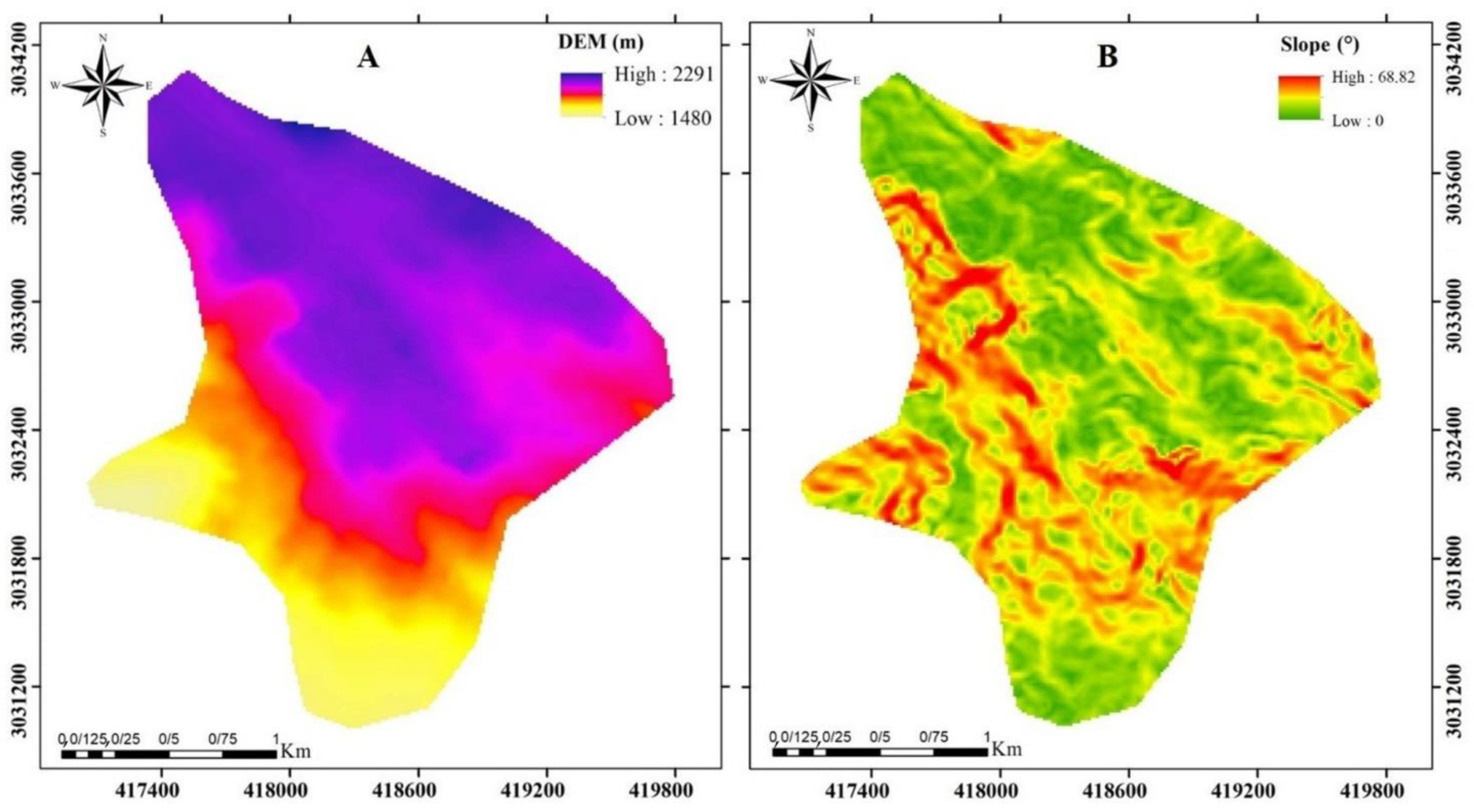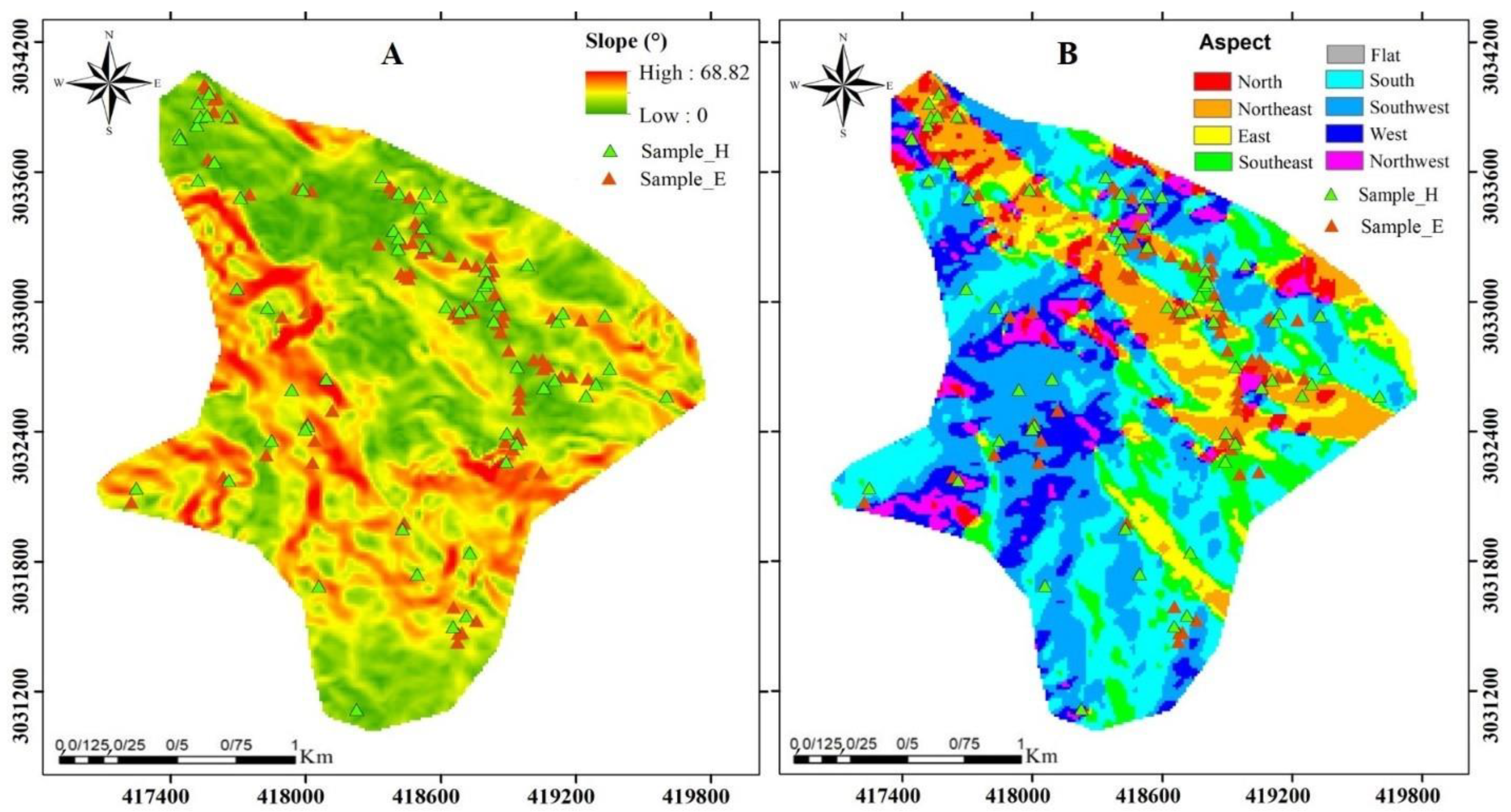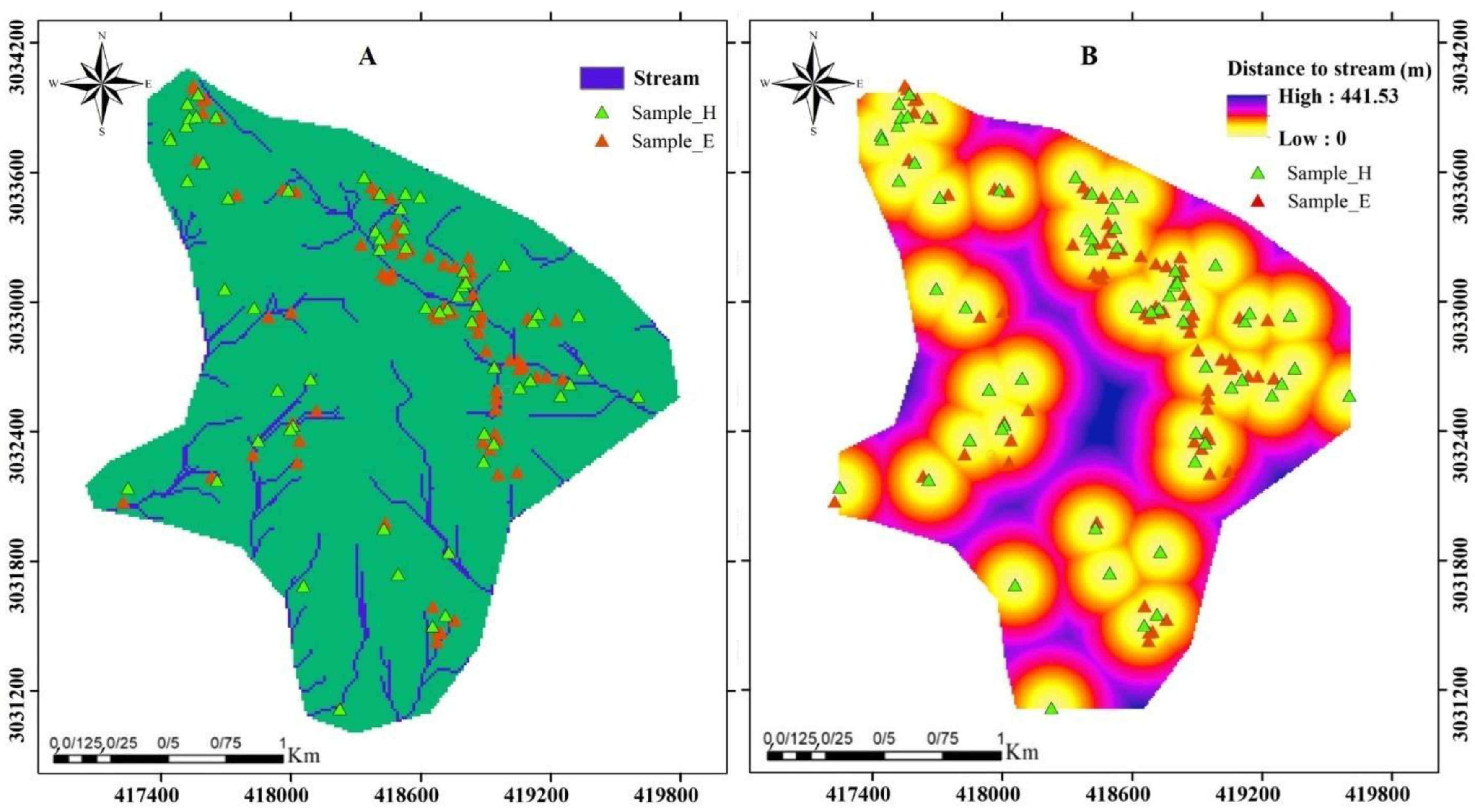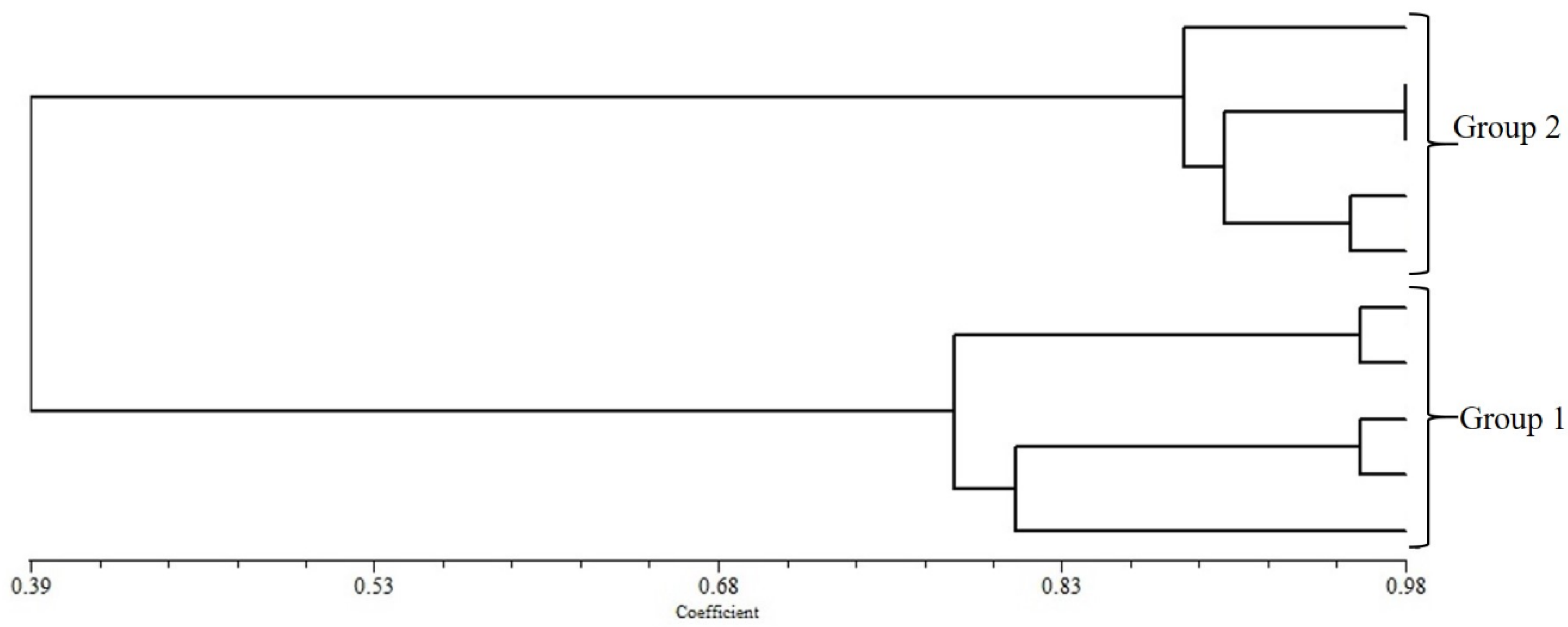Distribution and Physiology of Juniperus seravschanica Trees in the Genow—The Southernmost and Arid Habitat of Iran
Abstract
1. Introduction
2. Materials and Methods
2.1. Study Area
2.2. Assaying the Effects of Topographical and Climatic Factors on Species Distribution
2.3. Physiological Evaluation of Population
2.3.1. Physiological Assessment
2.3.2. Assessment of Genetic Diversity
2.4. Data Analysis
3. Results
3.1. Topographical Factors’ Effects on Species Distribution
3.2. Climatic Factors’ Effects on Species Distribution
3.3. Physiological Assessments
3.4. Populations’ Genetic Assessments
4. Discussion
5. Conclusions
Author Contributions
Funding
Conflicts of Interest
References
- Najafi Tireh-Shabankareh, K.; Jalili, A.; Khorasani, N.; Jamzad, Z.; Asri, Y. Flora, life forms and chorotypes of plants in the Genu protected area, Hormozgan province (Iran). Pajouhesh Sazandegi 2006, 69, 50–62. (In Persian) [Google Scholar]
- Makhdoum, M. National, Forest and Natural Parks; University Publication Center: Tehran, Iran, 2011. (In Persian) [Google Scholar]
- Soltanipoor, M.A.; Jonubi, P.; Hesamzadeh Hejazi, S.M.; Mirza, M. Morphometric study of the medicinal and endangered Zhumeria majdae. J. Plant Res. 2018, 31, 1–13. (In Persian) [Google Scholar]
- Poorasghariyan, A.; Sisipoor, M.; Ranjbar, S. Evaluation of Bandar-Abbas climate towards the development of tourism. In Proceedings of the 1st National Congress of Health, Environment and Susceptible Development, Islamic Azad University, Bandar-Abas Branch, Bandar Abbas, Iran, 20 February 2011; pp. 1–8. [Google Scholar]
- Adams, R.P.; Hojjati, F. Taxonomy of Juniperus in Iran: Insight from DNA sequencing. Phytologia 2012, 94, 219–227. [Google Scholar]
- Adams, R.P.; Al-Farsi, A.; Schwarzback, A.E. Confirmation of the southern-most population of Juniperus seravschanica in Oman by DNA sequencing of nrDNA and four cpDNA regions. Phytologia 2014, 96, 218–224. [Google Scholar]
- Adams, R.P.; Hojjati, F.; Schwarzbach, A.E. Taxonomy of Juniperus in Iran: DNA sequences of nrDNA plus three cpDNAs reveal Juniperus polycarpos var. turcomanica and J. seravschanica in southern Iran. Phytologia 2014, 96, 19–25. [Google Scholar]
- Hojjati, F.; Kazempour-Osaloo, S.; Adams, R.P.; Assadi, M. Molecular phylogeny of Juniperus in Iran with special reference to the J. excelsa complex, focusing on J. seravschanica. Phytotaxa 2018, 375, 135–157. [Google Scholar] [CrossRef]
- Jafari, M. Forests Genetic Resources in Iran. The Report on the State of the World’s Forest Genetic Resources. 2012, pp. 1–133. Available online: www.fao.org/documents (accessed on 13 June 2012).
- Bhattarai, S.; Chaudhary, R.P.; Taylor, R.S.L. Plants used as fence and fuelwood in manang district, Central Nepal. Sci. World 2007, 5, 107–111. [Google Scholar] [CrossRef]
- Miceli, N.; Marino, A.; Köroğlu, A.; Cacciola, F.; Dugo, P.; Mondello, L.; Taviano, M.F. Comparative study of the phenolic profile, antioxidant and antimicrobial activities of leaf extracts of five Juniperus L. (Cupressaceae) taxa growing in Turkey. Nat. Prod. Res. 2018, 34, 1636–1641. [Google Scholar] [CrossRef]
- Zhang, Y.; Wu, D.; Kuang, S.; Qing, M.; Ma, Y.; Yang, T.; Wang, T.; Li, D. Chemical composition, antioxidant, antibacterial and cholinesterase inhibitory activities of three Juniperus species. Nat. Prod. Res. 2019, 34, 3531–3535. [Google Scholar] [CrossRef]
- Ahani, H.; Jalilvand, H.; Hosseini-Nasr, S.M.; Soltani-Kouhbanani, H.; Ghazi, M.R.; Mohammadzadeh, H. Reproduction of juniper (Juniperus polycarpos) in Khorasan Razavi, Iran. Sci. Pract. 2013, 15, 231–237. [Google Scholar] [CrossRef]
- Farjon, A. Juniperus communis. In The IUCN Red List of Threatened Species; IUCN: Cambridge, UK, 2013. [Google Scholar] [CrossRef]
- Kentelky, E. The analysis of rooting and growth peculiarities of Juniperus species propagated by cuttings. Bull. UASVM Hortic. 2011, 68, 380–385. [Google Scholar]
- El-Juhany, L. Forestland degradation and potential rehabilitation in southwest Saudi Arabia. Aust. J. Basic Appl. Sci. 2009, 3, 2677–2696. [Google Scholar]
- MacLaren, C.A. Climate change drives decline of Juniperus seravschanica in Oman. J. Arid. Environ. 2016, 128, 91–100. [Google Scholar] [CrossRef]
- Rahimian Boogar, A.; Salehi, H.; Pourghasemi, H.R.; Blaschke, T. Predicting Habitat Suitability and Conserving Juniperus spp. Habitat Using SVM and Maximum Entropy Machine Learning Techniques. Water 2019, 11, 2049. [Google Scholar] [CrossRef]
- Han, H.; Cho, S.; Song, J.; Seol, A.; Chung, H.; Kim, J.; Chung, J. Assessing the potential suitability of forest stands as Kirengeshoma koreana habitat using MaxEnt. Landsc. Ecol. Eng. 2014, 10, 339–348. [Google Scholar] [CrossRef]
- Sork, V.L. Gene flow and natural selection shape spatial patterns of genes in tree populations: Implications for evolutionary processes and applications. Evol. Appl. 2016, 9, 291–310. [Google Scholar] [CrossRef]
- Oyama, K.; Herrera-Arroyo, M.L.; Rocha-Ramírez, V.; Benítez-Malvido, J.; Ruiz-Sánchez, E.; González-Rodríguez, A. Gene flow interruption in a recently human-modified landscape: The value of isolated trees for the maintenance of genetic diversity in a Mexican endemic red oak. For. Ecol. Manag. 2017, 390, 27–35. [Google Scholar] [CrossRef]
- Becklin, K.M.; Anderson, J.T.; Gerhart, L.M.; Wadgymar, S.M.; Wessinger, C.A.; Ward, J.K. Examining Plant Physiological Responses to Climate Change through an Evolutionary Lens. Plant Physiol. 2016, 172, 635–649. [Google Scholar] [CrossRef]
- Ashraf, M.A.; Akbar, A.; Askari, S.H.; Iqbal, M.; Rasheed, R.; Hussain, I. Recent Advances in Abiotic Stress Tolerance of Plants Through Chemical Priming: An Overview. In Advances in Seed Priming; Springer: Berlin/Heidelberg, Germany, 2018; pp. 51–79. [Google Scholar]
- Benevenuto, R.F.; Agapito-Tenfen, S.Z.; Vilperte, V.; Wikmark, O.-G.; Van Rensburg, P.J.; Nodari, R.O. Molecular responses of genetically modified maize to abiotic stresses as determined through proteomic and metabolomic analyses. PLoS ONE 2017, 12, e0173069. [Google Scholar] [CrossRef]
- Jolly, W.M.; Hadlow, A.M.; Huguet, K. De-coupling seasonal changes in water content and dry matter to predict live conifer foliar moisture content. Int. J. Wildland Fire 2014, 23, 480–489. [Google Scholar] [CrossRef]
- Wang, F.; Zhang, F.; Gou, X.; Fonti, P.; Xia, J.; Cao, Z.; Liu, J.; Wang, Y.; Zhang, J. Seasonal variations in leaf-level photosynthesis and water use efficiency of three isohydric to anisohydric conifers on the Tibetan Plateau. Agric. For. Meteorol. 2021, 308–309, 108581. [Google Scholar] [CrossRef]
- Arend, M.; Link, R.M.; Patthey, R.; Hoch, G.; Schuldt, B.; Kahmen, A. Rapid hydraulic collapse as cause of drought-induced mortality in conifers. Proc. Natl. Acad. Sci. USA 2021, 118, e2025251118. [Google Scholar] [CrossRef]
- Brodribb, T.J.; Cochard, H. Hydraulic failure defines the recovery and point of death in water stressed conifers. Plant Physiol. 2009, 149, 575–584. [Google Scholar] [CrossRef]
- Choat, B.; Jansen, S.; Brodribb, T.J.; Cochard, H.; Delzon, S.; Bhaskar, R.; Bucci, S.J.; Feild, T.S.; Gleason, S.M.; Hacke, U.G.; et al. Global convergence in the vulnerability of forests to drought. Nature 2012, 491, 752–755. [Google Scholar] [CrossRef]
- Zavafer, A.; Labeeuw, L.; Mancilla, C. Global Trends of Usage of Chlorophyll Fluorescence and Projections for the Next Decade. Plant Phenomics 2020, 2020, 6293145. [Google Scholar] [CrossRef]
- Kelleher, C.T.; de Vries, S.M.G.; Baliuckas, V.; Bozzano, M.; Frýdl, J.; Goicoechea, P.G.; Ivankovic, M.; Kandemir, G.; Koskela, J.; Kozioł, C.; et al. Approaches to the Conservation of Forest Genetic Resources in Europe in the Context of Climate Change; European Forest Genetic Resources Programme (EUFORGEN), Bioversity International: Rome, Italy, 2015; pp. i–xiv, 1–46. [Google Scholar]
- Kim, E.H.; Shin, J.K.; Jeong, K.S.; Lee, C.S.; Chung, J.M. Genetic variation and structure of Juniperus chinensis L. (Cupressaceae) in Korea. J. Ecol. Environ. 2018, 42, 14. [Google Scholar] [CrossRef]
- Nilon, C.H. Urban biodiversity and the importance of management and conservation. Landsc. Ecol. Eng. 2011, 7, 45–52. [Google Scholar] [CrossRef]
- Burczyk, J.; Chybicki, I.J. Cautions on direct gene flow estimation in plant populations. Evolution 2004, 58, 956–963. [Google Scholar] [CrossRef]
- Hamrick, J.L. Response of forest trees to global environmental changes. For. Ecol. Manag. 2004, 197, 323–335. [Google Scholar] [CrossRef]
- Moshir Panahi, D.; Kalantari, Z.; Ghajarnia, N.; Seifollahi-Aghmiuni, S.; Destouni, G. Variability and change in the hydroclimate and water resources of Iran over a recent 30-year period. Sci. Rep. 2020, 10, 7450. [Google Scholar] [CrossRef]
- O’Brien, R.M. A Caution Regarding Rules of Thumb for Variance Inflation Factors. Qual. Quant. 2007, 41, 673–690. [Google Scholar] [CrossRef]
- AOAC. Official Methods of Analysis; Association of Official Analysis Chemists: Arlington, VA, USA, 2008; pp. 1–15. [Google Scholar]
- Kovar, M.; Brestic, M.; Sytar, O.; Barek, V.; Hauptvogel, P.; Zivcak, M. Evaluation of Hyperspectral Reflectance Parameters to Assess the Leaf Water Content in Soybean. Water 2019, 11, 443. [Google Scholar] [CrossRef]
- Grzesiak, S.; Hordyńska, N.; Szczyrek, P.; Grzesiak, M.T.; Noga, A.; Szechyńska-Hebda, M. Variation among wheat (Triticum easativum L.) genotypes in response to the drought stress: I—Selection approaches. J. Plant Interact. 2019, 14, 30–44. [Google Scholar] [CrossRef]
- Weatherley, P.E. Studies in the water relations of the cotton plant. New Phytol. 1950, 49, 81–97. [Google Scholar] [CrossRef]
- Barrs, H.D. Determination of Water Deficit in Plant Tissues. In Water Deficit and Plant Growth; Kozlowski, T.T., Ed.; Academic Press: New York, NY, USA, 1986; pp. 235–368. [Google Scholar]
- Bajji, M.; Kinet, J.M.; Lutts, S. The use of the electrolyte leakage method for assessing cell membrane stability as a water stress tolerance test in durum wheat. Plant Growth Regul. 2002, 36, 61–70. [Google Scholar] [CrossRef]
- Blanke, M.M. Determination of chlorophyll using DMSO. Vitic. Enol. Sci. 1992, 47, 32–35. [Google Scholar]
- Bates, L.S.; Waldren, R.P.; Teare, I.D. Rapid determination of free proline for water-stress studies. Plant Soil 1973, 39, 205–207. [Google Scholar] [CrossRef]
- Lodhi, M.A.; Ye, G.N.; Weeden, N.F.; Reisch, B.I. A Simple and Efficient Method for DNA Extraction from Grapevine Cultivars and Vitis Species. Plant Mol. Biol. Rep. 1994, 12, 6–13. [Google Scholar] [CrossRef]
- Wang, J.; Wang, H.; Cao, Y.; Bai, Z.; Qin, Q. Effects of soil and topographic factors on vegetation restoration in opencast coal mine dumps located in a loess area. Sci. Rep. 2016, 6, 22058. [Google Scholar] [CrossRef]
- Wang, C.; Wang, J.; Naudiyal, N.; Wu, N.; Cui, X.; Wei, Y.; Chen, Q. Multiple Effects of Topographic Factors on Spatio-Temporal Variations of Vegetation Patterns in the Three Parallel Rivers Region, Southeast Qinghai-Tibet Plateau. Remote Sens. 2022, 14, 151. [Google Scholar] [CrossRef]
- Brown, J.H.; Gillooly, J.F.; Allen, A.P.; Savage, V.M.; West, G.B. Toward a metabolic theory of ecology. Ecology 2004, 85, 1771–1789. [Google Scholar] [CrossRef]
- García, F.C.; Bestion, E.; Warfield, R.; Yvon-Durocher, G. Changes in temperature alter the relationship between biodiversity and ecosystem functioning. Proc. Natl. Acad. Sci. USA 2018, 115, 10989–10994. [Google Scholar] [CrossRef]
- Lusk, C.H.; Wiser, S.K.; Laughlin, D.C. Macroclimate and topography interact to influence the abundance of divaricate plants in New Zealand. Front. Plant Sci. 2020, 11, 507. [Google Scholar] [CrossRef]
- Fischer, E.M.; Seneviratne, S.I.; Vidale, P.L.; Luthi, D.; Schar, C. Soil moisture—Atmosphere interactions during the 2003 European summer heat wave. J. Clim. 2007, 20, 5081–5099. [Google Scholar] [CrossRef]
- IUCN. The IUCN Red List of Threatened Species; IUCN: Gland, Switzerland, 2016. [Google Scholar]
- Tirado, R.; Cotter, J. Ecological Farming: Drought-Resistant Agriculture; Greenpeace Research Laboratories, University of Exeter: Exeter, UK, 2010; pp. 1–16. [Google Scholar]
- Workie, T.G.; Debella, H.J. Climate Change and Its Effects on Vegetation Phenology across Ecoregions of Ethiopia. Glob. Ecol. Conserv. 2017, 13, e00366. [Google Scholar] [CrossRef]
- Wang, C.; Liu, C.; Wan, J.; Zhang, Z. Climate change may threaten habitat suitability of threatened plant species within Chinese nature reserves. PeerJ 2016, 4, e2091. [Google Scholar] [CrossRef]
- Guo, Y.; Guo, J.; Shen, X.; Wang, G.; Wang, T. Predicting the Bioclimatic Habitat Suitability of Ginkgo biloba L. in China with Field-Test Validations. Forests 2019, 10, 705. [Google Scholar] [CrossRef]
- Bréda, N.; Huc, R.; Granier, A.; Dreyer, E. Temperate forest trees and stands under severe drought: A review of ecophysiological responses, adaptation processes and long-term consequences. Ann. For. Sci. 2006, 63, 625–644. [Google Scholar] [CrossRef]
- Wolfe, B.T.; Sperry, J.S.; Kursar, T.A. Does leaf shedding protect stems from cavitation during seasonal droughts? A test of the hydraulic fuse hypothesis. New Phytol. 2016, 212, 1007–1018. [Google Scholar] [CrossRef]
- Polle, A.; Chen, S.L.; Eckert, C.; Harfouche, A. Engineering Drought Resistance in Forest Trees. Front. Plant Sci. 2019, 9, 1875. [Google Scholar] [CrossRef]
- Du, B.; Jansen, K.; Kleiber, A.; Eiblmeier, M.; Kammerer, B.; Ensminger, I.; Gessler, A.; Rennenberg, H.; Kreuzwieser, J. A coastal and an interior Douglas-fir provenance exhibit different metabolic strategies to deal with drought stress. Tree Physiol. 2016, 36, 148–163. [Google Scholar] [CrossRef] [PubMed]
- Kleiber, A.; Duan, Q.; Jansen, K.; Junker, L.V.; Kammerer, B.; Rennenberg, H.; Ensminger, I.; Gessler, A.; Kreuzwieser, J. Drought effects on root and needle terpenoid content of a coastal and an interior Douglas-Fir provenance. Tree Physiol. 2017, 37, 1648–1658. [Google Scholar] [CrossRef] [PubMed]
- Allen, C.D.; Breshears, D.D.; McDowell, N.G. On underestimation of global vulnerability to tree mortality and forest die-off from hotter drought in the Anthropocene. Ecosphere 2015, 6, 155. [Google Scholar] [CrossRef]
- McCauley, L.A.; Bradford, J.B.; Robles, M.D.; Shriver, R.K.; Woolley, T.J.; Andrews, C.A. Landscape-scale forest restoration decreases vulnerability to drought mortality under climate change in southwest USA ponderosa forest. For. Ecol. Manag. 2022, 509, 120088. [Google Scholar] [CrossRef]
- Wlostowski, A.N.; Jennings, K.S.; Bash, R.E.; Burkhardt, J.; Wobus, C.W.; Aggett, G. Dry landscapes and parched economies: A review of howdrought impacts nonagricultural socioeconomic sectorsin the US Intermountain West. WIREs Water 2022, 9, e1571. [Google Scholar] [CrossRef]
- Medeiros, D.B.; da Silva, E.C.; Santos, H.R.B.; Pacheco, C.M.; Musser, R.S.; Nogueira, R.J.M.C. Physiological and biochemical responses to drought stress in Barbados cherry. Braz. J. Plant Physiol. 2012, 24, 181–192. [Google Scholar] [CrossRef]
- Du, P.; Arndt, S.K.; Farrell, C. Relationships between plant drought response, traits, and climate of origin for green roof plant selection. Ecol. Appl. 2018, 28, 1752–1761. [Google Scholar] [CrossRef]
- Hussein, H.A.A.; Alshammari, S.O.; Kenawy, S.K.M.; Elkady, F.M.; Badawy, A.A. Grain-Priming with L-Arginine Improves the Growth Performance of Wheat (Triticum aestivum L.) Plants under Drought Stress. Plants 2022, 11, 1219. [Google Scholar] [CrossRef]
- Poyatos, R.; Llorens, P.; Piñol, J.; Rubio, C. Response of Scots pine (Pinus sylvestris L.) and pubescent oak (Quercus pubescens Willd.) to soil and atmospheric water deficits under Mediterranean mountain climate. Ann. For. Sci. 2008, 65, 306. [Google Scholar] [CrossRef]
- Couso, L.L.; Fernández, R.J. Phenotypic plasticity as an index of drought tolerance in three Patagonian steppe grasses. Ann. Bot. 2012, 110, 849–857. [Google Scholar] [CrossRef]
- Luo, Z.; Guan, H.; Zhang, X.; Zhang, C.; Liu, N.; Li, G. Responses of plant water use to a severe summer drought for two subtropical tree species in the central southern China. J. Hydrol. 2016, 8, 1–9. [Google Scholar] [CrossRef]
- Diamantoglou, S.; Rhizopoulou, S. Free Proline Accumulation in Sapwood, Bark and Leaves of Three Evergreen Sclerophylls and a Comparison with an Evergreen Conifer. J. Plant Plrysiol. 1992, 140, 361–365. [Google Scholar] [CrossRef]
- Shinde, S.S.; Kachare, D.P.; Satbhai, R.D.; Naik, R.M. Water stress induced proline accumulation and antioxidative enzymes in groundnut (Arachis hypogaea L.). Legum. Res. 2018, 41, 67–72. [Google Scholar] [CrossRef][Green Version]
- Liang, X.; Zhang, L.; Natarajan, S.K.; Becker, D.F. Proline Mechanisms of Stress Survival. Antioxid. Redox Signal. 2013, 19, 998–1011. [Google Scholar] [CrossRef]
- Molinari, H.C.; Marura, C.J.; Darosb, E.; Freitas de Camposa, M.K.; Portela de Carvalhoa, J.F.R.; Filhob, J.B.; Pereirac, L.P.; Vieira, L.E. Evaluation of the stress inducible production of proline in transgenic sugarcane (Saccharum spp.) osmotic adjustment, chlorophyll fluorescence and oxidative stress. Physiol. Planta 2007, 130, 218–229. [Google Scholar] [CrossRef]
- Alhasnawi, A.N. Role of proline in plant stress tolerance: A mini review. Res. Crops 2019, 20, 223–229. [Google Scholar]
- Vendruscolo, E.C.G.; Schuster, I.; Pileggi, M.; Scapim, C.A.; Molinari, H.B.C.; Marur, C.J.; Vieira, L.G.E. Stress-induced synthesis of proline confers tolerance to water deficit in transgenic wheat. J. Plant Physiol. 2007, 164, 1367–1376. [Google Scholar] [CrossRef]
- Tezcan, A.; Aslan, G.E. Kaman, H. Evaluation of drought stress on the chlorophyll content of the plants: A review on the solanaceae family. Fresenius Environ. Bull. 2019, 28, 4636–4641. [Google Scholar]
- Shin, Y.K.; Bhandari, S.R.; Jo, J.S.; Song, J.W.; Lee, J.G. Effect of Drought Stress on Chlorophyll Fluorescence Parameters, Phytochemical Contents, and Antioxidant Activities in Lettuce Seedlings. Horticulturae 2021, 7, 238. [Google Scholar] [CrossRef]
- Teshome, D.T.; Zharare, G.E.; Naidoo, S. The Threat of the Combined Effect of Biotic and Abiotic Stress Factors in Forestry Under a Changing Climate. Front. Plant Sci. 2020, 11, 601009. [Google Scholar] [CrossRef]
- Moran, E.; Lauder, J.; Musser, C.; Stathos, A.; Shu, M. The genetics of drought tolerance in conifers. New Phytol 2017, 216, 1034–1048. [Google Scholar] [CrossRef] [PubMed]
- Koepke, D.F.; Kolb, T.E.; Adams, H.D. Variation in woody plant mortality and dieback from severe drought among soils, plant groups, and species within a northern Arizona ecotone. Oecologia 2010, 163, 1079–1090. [Google Scholar] [CrossRef]
- Eldhuset, T.D.; Nagy, N.E.; Volařík, D.; Børja, I.; Gebauer, R.; Yakovlev, I.A.; Krokene, P. Drought affects tracheid structure, dehydrin expression, and above- and belowground growth in 5-year-old Norway spruce. Plant Soil 2013, 366, 305–320. [Google Scholar] [CrossRef]
- Lenoir, J.; Gégout, J.C.; Marquet, P.A.; de Ruffray, P.; Brisse, H. A significant upward shift in plant species optimum elevation during the 20th century. Science 2008, 320, 1768–1771. [Google Scholar] [CrossRef] [PubMed]
- McInerny, G.J.; Turner, J.R.G.; Wong, H.Y.; Travis, J.M.J.; Benton, T.G. How range shifts induced by climate change affect neutral evolution. Proc. R. Soc. B 2009, 276, 1527–1534. [Google Scholar] [CrossRef] [PubMed]







| Model | Unstandardized Coefficients | Standardized Coefficients | t | Sig. | Collinearity Statistics | |||
|---|---|---|---|---|---|---|---|---|
| B | Std. Error | Beta | Tolerance | VIF | ||||
| 1 | 1 (Constant) | −14.644 | 4.226 | −3.466 | .018 | |||
| Min-Temperature | 0.361 | 0.499 | 0.134 | 0.723 | 0.502 | 0.783 | 1.278 | |
| Max-Temperature | 0.419 | 0.096 | 1.007 | 4.389 | 0.007 | 0.510 | 1.962 | |
| Wind speed | 0.081 | 0.037 | 0.410 | 2.209 | 0.078 | 0.779 | 1.284 | |
| Precipitation | 0.003 | 0.005 | 0.158 | 0.626 | 0.559 | 0.420 | 2.383 | |
| Variables | Tree Groups | Min-Temp. | Max-Temp. | Wind Speed | Annual Precip. | Chlorophyll | Proline | RWC | RT | WD | EL |
|---|---|---|---|---|---|---|---|---|---|---|---|
| Tree groups | 1 | ||||||||||
| Min-temp. | 0.108 | 1 | |||||||||
| Max-temp. | −0.833 ** | −0.341 | 1 | ||||||||
| Wind speed | −0.317 | 0.090 | −0.059 | 1 | |||||||
| Annual Precip. | 0.559 * | 0.413 | −0.652* | −0.283 | 1 | ||||||
| Chlorophyll | 0.786 ** | −0.180 | −0.676 * | −0.347 | 0.418 | 1 | |||||
| Proline | −0.837 ** | −0.140 | 0.918 ** | 0.182 | −0.640 * | −0.778 ** | 1 | ||||
| RWC | 0.947 ** | 0.220 | −0.798 ** | −0.290 | 0.413 | 0.668 * | −0.742 * | 1 | |||
| RT | 0.935 ** | −0.003 | −0.703 * | −0.421 | 0.485 | 0.872 ** | −0.702 * | 0.887 ** | 1 | ||
| WD | −0.935 ** | 0.003 | 0.703 * | 0.421 | −0.485 | −0.872 ** | 0.702 * | −0.887 ** | −1.000 ** | 1 | |
| EL | −0.884 ** | −0.081 | 0.709 * | 0.393 | −0.465 | −0.549 | 0.786 ** | −0.865 ** | −0.720 * | 0.720 * | 1 |
| Independent Samples Test | ||||||
|---|---|---|---|---|---|---|
| Levene’s Test for Equality of Variances | t-Test for Equality of Means | |||||
| t | df | Sig. (2-Tailed) | Mean Difference | 95% Confidence Interval of the Difference | ||
| Lower | Upper | |||||
| Chlorophyll | −3.597 | 8 | 0.007 ** | 0.26246 | −1.54924 | −0.33876 |
| Proline | 4.330 | 8 | 0.003 ** | 0.27622 | 0.55904 | 1.83296 |
| RWC | −8.303 | 8 | 0.000 ** | 1.26949 | −13.46744 | −7.61256 |
| RT | −7.428 | 8 | 0.000 ** | 0.63008 | −6.13297 | −3.22703 |
| WD | 7.428 | 8 | 0.000 ** | 0.63008 | 3.22703 | 6.13297 |
| EL | 5.347 | 8 | 0.001 ** | 1.02189 | 3.10752 | 7.82048 |
| Tree Samples | N | Mean | Std. Deviation | Std. Error Mean | |
|---|---|---|---|---|---|
| Chlorophyll | with dried branches | 5 | 1.9560 | 0.49943 | 0.22335 |
| without dried branches | 5 | 2.9000 | 0.30822 | 0.13784 | |
| Proline | with dried branches | 5 | 2.3900 | 0.60237 | 0.26939 |
| without dried branches | 5 | 1.1940 | 0.13649 | 0.06104 | |
| RWC | with dried branches | 5 | 38.0000 | 2.23607 | 1.00000 |
| without dried branches | 5 | 48.5400 | 1.74871 | 0.78205 | |
| RT | with dried branches | 5 | 93.1800 | 1.21326 | 0.54259 |
| without dried branches | 5 | 97.8600 | 0.71624 | 0.32031 | |
| WD | with dried branches | 5 | 6.8200 | 1.21326 | 0.54259 |
| without dried branches | 5 | 2.1400 | 0.71624 | 0.32031 | |
| EL | with dried branches | 5 | 14.1400 | 1.45162 | 0.64918 |
| without dried branches | 5 | 8.6760 | 1.76468 | 0.78919 | |
| Source | df | SS | MS | Est. Var. | % | PhiPTSstat | |
|---|---|---|---|---|---|---|---|
| Value | p (Rand ≥ Data) | ||||||
| Among groups | 1 | 84.500 | 84.500 | 16.230 | 83% | 0.829 | 0.007 |
| Within groups | 8 | 26.800 | 3.350 | 3.350 | 17% | ||
| Total | 9 | 111.300 | 19.580 | 100% | |||
Publisher’s Note: MDPI stays neutral with regard to jurisdictional claims in published maps and institutional affiliations. |
© 2022 by the authors. Licensee MDPI, Basel, Switzerland. This article is an open access article distributed under the terms and conditions of the Creative Commons Attribution (CC BY) license (https://creativecommons.org/licenses/by/4.0/).
Share and Cite
Rahimian Boogar, A.; Salehi, H.; Seyedabadi, E. Distribution and Physiology of Juniperus seravschanica Trees in the Genow—The Southernmost and Arid Habitat of Iran. Water 2022, 14, 3508. https://doi.org/10.3390/w14213508
Rahimian Boogar A, Salehi H, Seyedabadi E. Distribution and Physiology of Juniperus seravschanica Trees in the Genow—The Southernmost and Arid Habitat of Iran. Water. 2022; 14(21):3508. https://doi.org/10.3390/w14213508
Chicago/Turabian StyleRahimian Boogar, Abdolrahman, Hassan Salehi, and Esmaeel Seyedabadi. 2022. "Distribution and Physiology of Juniperus seravschanica Trees in the Genow—The Southernmost and Arid Habitat of Iran" Water 14, no. 21: 3508. https://doi.org/10.3390/w14213508
APA StyleRahimian Boogar, A., Salehi, H., & Seyedabadi, E. (2022). Distribution and Physiology of Juniperus seravschanica Trees in the Genow—The Southernmost and Arid Habitat of Iran. Water, 14(21), 3508. https://doi.org/10.3390/w14213508







